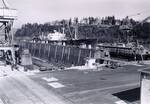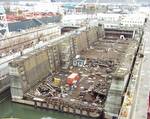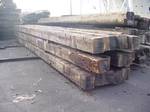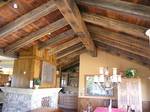Portland Wooden Drydock Yields Beautiful DF Timbers
Trestlewood recently acquired all of the remaining materials from Drydock #2 at the Portland Shipyard. We are pleased to share some of the history of this grand old structure and offer the old timbers as structural or aesthetic elements for your next project.
| Construction of Drydock #2 was commissioned by the City of Portland in 1920. It was constructed with locally-harvested Douglas Fir timbers, with the pontoons (the floating part) being constructed with untreated timbers and the wingwalls (the walls which extend above the water) being painted with a CCA treatment. |
| Before and during World War II, Swan Island in Portland was transformed from a small airfield into one of the dozens of newly-minted shipyards building ships for the U.S. Maritime Commission. Swan Island was one of the Kaiser Shipyards which were located on the West Coast and ended up being one of the most efficient shipyards in the country. |
| The Kaiser Shipyards built dozens of ships for the U.S. Maritime Commission. Liberty Ships and T2 Tankers were built to supply the transport needs of the Armed Services in Asia and Europe. More tankers were built at Swan Island than at any other shipyard on the West Coast (T2 Tankers built at Swan Island). Drydock #2 was also used heavily in retrofitting existing ships and repairing damaged ships. The Portland yards feature prominently on this History of US Shipbuilding during WWII. For truly compelling primary source material about what life would have been like for the workers at the Swan Island Shipyard, please see The Bosn's Whistle, the Kaiser Company newsletter of the time. |
| Over time, stout old Drydock #2 became smaller and smaller compared to modern steel drydocks and finally its useful life as a drydock came to an end. |
| The useful life of the timbers which made up Drydock #2 is just beginning, however. The primary timbers from the drydock are 10x10s, 10x12s, 10x14s and 10x16s. The bottom decking of the drydock are 4x13s. The lengths of the material range from 10's up to 40's. |
| The drydock timbers are available for re-use in applications where large, long weathered Douglas Fir timbers are called for. In this case, these timbers' beauty is matched by their romantic history. |
On August 16, 1941, the Liberty Ship "Ocean Vanguard" was launched with great fanfare from one of the Kaiser Shipyards. A brass band played patriotic tunes and Emory S. Land, chairman of the U.S. Maritime Commission, gave a rousing speech. "Give us the tools and we will finish the job," he quoted Churchill. "But the tools must be where the job is to be done--the other side of the Atlantic. If we have the ships, and only if we have the ships, to carry them across the ocean, we can win."
Henry J. Kaiser, owner of the yard, was next to the podium. His speech was short and more subdued. He thanked his men and associates and then he endeavored to speak for the ship:
"I wish the ship could speak for herself. She would tell you of the strong and capable hands that piece by piece, put together every vital part of her. She would tell you of the inspired coordination and cooperation which cut time to a minimum and made it possible to make her a living thing out of inaminate materials. She would give you her thanks for her life and pledge you faithful service in the fight for freedom. She would give you a message of courage, faith, hope and cheer. To the men who built her and their wives and sweethearts with sincere appreciation and gratitude, this mass of steel, about to become a great ship, says thank you!"
Regrettably, the brass bands and fanfare are reserved for the birth of great ships. The end of even great ships happens in the quiet hours of dusk. More so for non-descript support structures like Drydock #2. But at the end of the life of this beautifully strong, stout Drydock #2, we agree with Henry Kaiser. We wish that Drydock #2 could speak for herself, for oh, the stories she would tell...
This email is intended to be received by those who have requested information from the Trestlewood periodic email updates. If this email has reached you in error, we apologize for any inconvenience it has caused. To unsubscribe, please email us by clicking here






